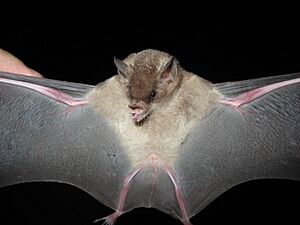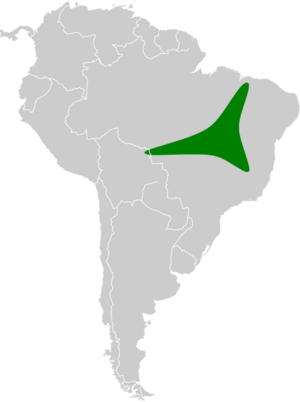Dekeyser's nectar bat facts for kids
Quick facts for kids Dekeyser's nectar bat |
|
|---|---|
 |
|
| Conservation status | |
| Scientific classification | |
| Genus: |
Lonchophylla
|
| Species: |
dekeyseri
|
 |
|
The Dekeyser's nectar bat (Lonchophylla dekeyseri) is a type of bat that lives in parts of Brazil and Bolivia. It's known for feeding mostly on nectar, like a hummingbird!
Contents
How Was This Bat Discovered?
Scientists first found the Dekeyser's nectar bat in August 1970. They discovered it in a place called Brasília National Park in Brazil.
Three scientists, Valdir Taddei, Luiz Vizotto, and Ivan Sazima, officially described this new species in 1983. They named it dekeyseri to honor a French zoologist named Pierre Louis Dekeyser.
What Does It Look Like?
Dekeyser's nectar bats are quite small. They weigh about 10.7 grams, which is less than half an ounce. Their forearms are about 35 millimeters (1.4 inches) long.
Their bellies are a lighter color than their backs. Compared to other bats in its group (the Lonchophylla genus), this bat is one of the smaller ones. It also has a shorter skull than many of its relatives.
These bats have a small nose-leaf, which is a special skin flap on their nose. Their ears are about 14 millimeters (0.55 inches) long. Inside their ears, there's a pointy part called a tragus, which is about 5 millimeters (0.2 inches) long. They also have a grooved lower lip with small bumps around it.
What Does It Eat and How Does It Live?
Dekeyser's nectar bats live in an area of about 564 to 640 hectares (about 2.2 to 2.5 square miles). This area includes both natural grasslands called cerrado and open pasture land.
These bats are nectarivores, meaning they mainly eat nectar from flowers. They get nectar from many different plants, including Hymenaea stigonocarpa, various Bauhinia trees, and Luehea trees. They also feed on nectar from Lafoensia and Pseudobombax plants.
During the dry season, when there's lots of nectar, they eat mostly nectar. But in the wet season, they add more insects and fruits to their diet.
Baby bats, called pups, are usually born between July and November. Scientists think these bats breed only once a year. Their roosts (where they sleep during the day) often have more females than males. This might mean they live in groups where one male has a "harem" of females.
These bats leave their roosts shortly after the sun sets and return just before the sun rises. In the dry season, they might even come back for a quick visit around midnight before heading out again.
Where Does It Live?
This bat species is found only in the Cerrado region of Brazil. The Cerrado is a large tropical grassland and savanna area.
Dekeyser's nectar bats depend on caves for their daytime roosts. They prefer to live in dry forests that have calcareous rock formations, which are often found near caves.
Why Is This Bat Endangered?
The Dekeyser's nectar bat is an endangered species. This means it's at a high risk of disappearing forever.
One big threat to these bats comes from efforts to control vampire bats. Sometimes, people try to get rid of vampire bats using methods that harm other bat species, including endangered ones like the Dekeyser's nectar bat. For example, some methods involve lighting dynamite in caves or sealing caves shut when bats are inside. These actions can kill many bats that are not vampire bats.
In 1996, the IUCN first listed this bat as "vulnerable." Then, in 2008, its status changed to "near threatened." But by 2016, it was listed as "endangered."
It's considered endangered because there are likely fewer than 2,500 individual bats left. Also, their habitat is shrinking quickly, and the places where they live are scattered and limited.
There are six known groups of these bats, and each group is thought to have fewer than 100 individuals. Since they live in areas with karst landscapes (which have caves and sinkholes), they are also threatened by mining activities that disturb these areas.


